Editor’s note: This is the third installment in Spectrum South’s Historians of the Queer South series. Each month, we share a new article highlighting a scholar who we think has made a particularly important contribution to our understanding of the queer southern past.
By Nikita Shepard
“My office is the gayest place on campus,” declares Professor Jerry T. Watkins III with a grin.
He’s not kidding. In the background behind him, I can see through my Zoom screen, the wall sports an LGBTQ pride flag, a poster of a renowned local Virginia queer cultural figure, buttons from the AIDS activist group ACT UP, and various other colorful items testifying to the unapologetic queerness of the office’s sole resident. It’s the kind of environment intended to make a statement—I’m here, I’m queer, and I’m not going anywhere. And to provide a safe space for any LGBTQ students who’ve arrived on campus in this small southern town wondering if there’s a place for them.
Professor Watkins, or “Jay” once you get to know him, serves as an associate teaching professor in the Harrison Ruffin Tyler Department of History at the College of William & Mary in Williamsburg, Virginia. I encountered him through Queering the Redneck Riviera: Sexuality and the Rise of Florida Tourism, his fascinating 2018 book on the LGBTQ history of a region not often discussed on the map of the queer South: the Florida Panhandle. We sat down to chat one late spring morning as he was wrapping up his semester of teaching. I learned a lot about the unconventional queer history of an overlooked region—where Stonewall made no impact, but tourism reigned supreme, and efforts to “unqueer” the region were fought not with protests, but with beach parties. And I also learned about one southern gay man’s defiant journey out of shame into pride, in which it took a trip across the Atlantic to be able to learn the history of the gay bar in the humble coastal town where he grew up.
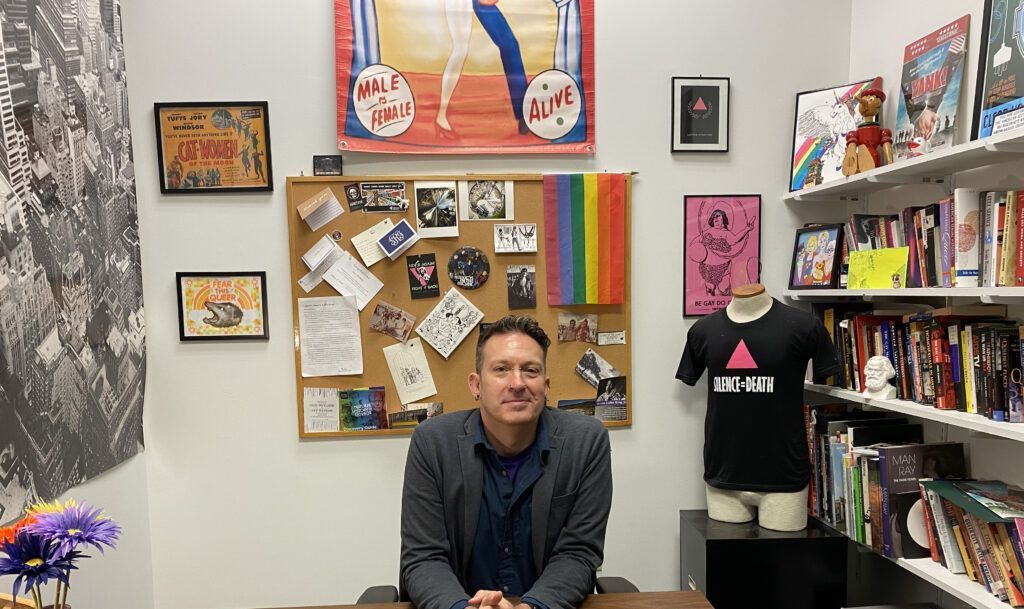
Jay Watkins called the Panhandle home for much of his life. He grew up in Panama City, Florida—best known to his generation as a vacation party town, MTV’s “spring break capital of the world.” He grew up Southern Baptist, going to church multiple times a week in a deeply conservative environment. When he realized that he had what he wryly describes as “a touch of the homosexualism,” he was ashamed. “I spent the 1990s trying to pray the gay away,” he admits.
It didn’t work. Instead, during those years, he struggled with substance use and addictive behaviors, a common trauma response for LGBTQ young people in unsupportive environments. He’s not bitter—his parents “did the best they knew how to do,” he recognizes now—but he moved away from the religious faith of his youth, came out permanently, and decided to make his impact on the world as an openly gay man in the South.
But what path should he take? Watkins chose a winding one with many false starts. At first, he’d planned to be a lawyer, until a short stint working at a firm convinced him that he hated it, leaving him “working at The Gap, like every homosexual had to do in the ʼ90s.” (I laughed out loud; in my town, it was Abercrombie and Fitch, but I see you!) In 2003, he went back to school to study marketing—but after a couple of weeks, he realized, “There’s no way I’m going to spend the next 50 years of my life selling people stuff they don’t need!” He locates in this realization an early indication of the left-leaning politics he proudly espouses today.
Then one day, he signed up for a course on the history of sexuality in the United States. He’d always liked history, and figured it might be fun—“I had no idea you could write history about sex!” The class blew his mind and sparked a lifelong interest, leading him to major in history and to write a senior thesis on an Atlanta magazine called Etcetera that covered LGBTQ, HIV/AIDS, and labor issues. He was curious about digging deeper into the South’s queer history, but how would he find a way?
The opportunity came while on a trip to London for a conference, where he got to meet his idol: historian John Howard, author of the influential 1999 study Men Like That on the queer history of Mississippi. Watkins had what he gleefully describes as his “fangirl moment” when the senior scholar and the eager student met for a drink at QBar in Trafalgar Square. Based on his thesis, he’d considered further researching queer Atlanta, but he hadn’t clarified a topic. Then, recalling his upbringing in Panama City, he happened to mention that the gay bar in his hometown had been open since 1965, a remarkable duration for a southern queer institution. Howard’s eyes lit up. “That’s what you need to write about!” the historian declared.
And so Watkins did. Applying to PhD programs, he was accepted to his dream school—none other than King’s College London, to study with his hero, John Howard. Expanding the scope of his curiosity from that hometown gay bar in Panama City, he broadened his research to cover the Panhandle, including the cities of Pensacola and Tallahassee. And the rest, as they say, is (queer) history.
How do you research the little-known queer history of a southern region? Well, for starters, head down to the bar. Watkins turned up in the region’s queer spaces and asked around, chatting with friends and acquaintances he knew from growing up there, and eventually made contacts for the 20 or so oral history interviews he would conduct. As the research moved along, he did some public talks, which led to more contacts, as folks from the audience would speak to him and share memories, photographs, and leads for interviews. This included both residents of the region as well as other southern gays and lesbians who would travel to the region for holidays. While Miami and Fort Lauderdale tended to attract wealthier queer travelers from the North who could afford to fly, vacationers from the South would drive from Atlanta or the Gulf Coast states to the “Redneck Riviera,” where a more accessible but still actively gay beachfront life took place in Panama City.
Watkins also drew on government archives, particularly the records of the Johns Committee—a notorious arm of the Florida legislature that investigated civil rights groups, left-wing organizations, and gay and lesbian communities in the 1950s and 1960s. As he dug through the records of the Committee’s investigations, he gradually began to notice a map of places and connections, what he calls a “deterritorialized community.” Deep into the process of writing the book, he spread stacks of photocopied papers around his bedroom, seeing this map of north Florida’s queer geography “emerge in front of my eyes.”
In addition to bars and private homes, a major part of this landscape took the form of public parks and restrooms. Watkins recalls that his own first experience with gay sex took place in a park. Only when he began studying the region’s queer past did he come to realize that he was “engaged in a much longer history than I knew. This wasn’t new or special; this is a thing we’ve been doing for ages.” One of the most tragic sections of his book describes police repression of gay sexual networks, notably in a 1961 series of raids in Panama City that resulted in dozens of arrests.
These periodic crackdowns stemmed from the investment of the region’s political and business elites in the image of north Florida as a more “family friendly” tourism destination. Miami and its environs were highly popular among vacationers but associated with glamor and vice. Boosters for the Panhandle, eager to frame a narrative that would keep those visitors and their tourism dollars flowing into the region, were determined to impose this “family friendly” model on the region—at the expense of whoever might stand in the way. As Watkins notes dryly, “You want just enough sin to keep people coming back, but not too much sin to keep away the ‘good’ tourists.” Queers and other sexual nonconformists, along with gamblers, sex workers, poor communities of color, and other marginalized groups, often found themselves targets of these “clean-up” efforts, especially when an election was around the corner. (Sound familiar, anyone?)
Watkins describes this process of policing, shaming, and silencing in the region as “unqueering.” Borrowing the term from scholar Carol Mason, author of Oklahomo, he uses it to refer to the process of “flattening out sexual difference through the active oppression, exclusion, or erasure of queer people.”
That’s why his book is titled Queering the Redneck Riviera. If the politicians, police, business leaders, and religious activists he tracks aimed to “unqueer” the region, history can help to excavate the stories of queer life, love, and lust that have been obscured by their efforts.
One such story he shares in the book is about the Emma Jones Society, a gay social club founded in Pensacola in the 1960s. Two male lovers who presented themselves as adopted brothers set up a post office box under a deceptively boring alias (“‘Emma’ because it was such an awful name, ‘Jones’ because it was so common,” as the founders put it), establishing a correspondence network that gradually grew into a massive beach party. While some gay networks in the region reproduced the racism and snobbery that reflected the larger culture, the Emma Jones Society was multi-racial and multi-gender—and very popular. In the 1970s, when the first Pride gatherings in the region were measured in the dozens, the Society’s beach parties could draw gay crowds in the thousands.
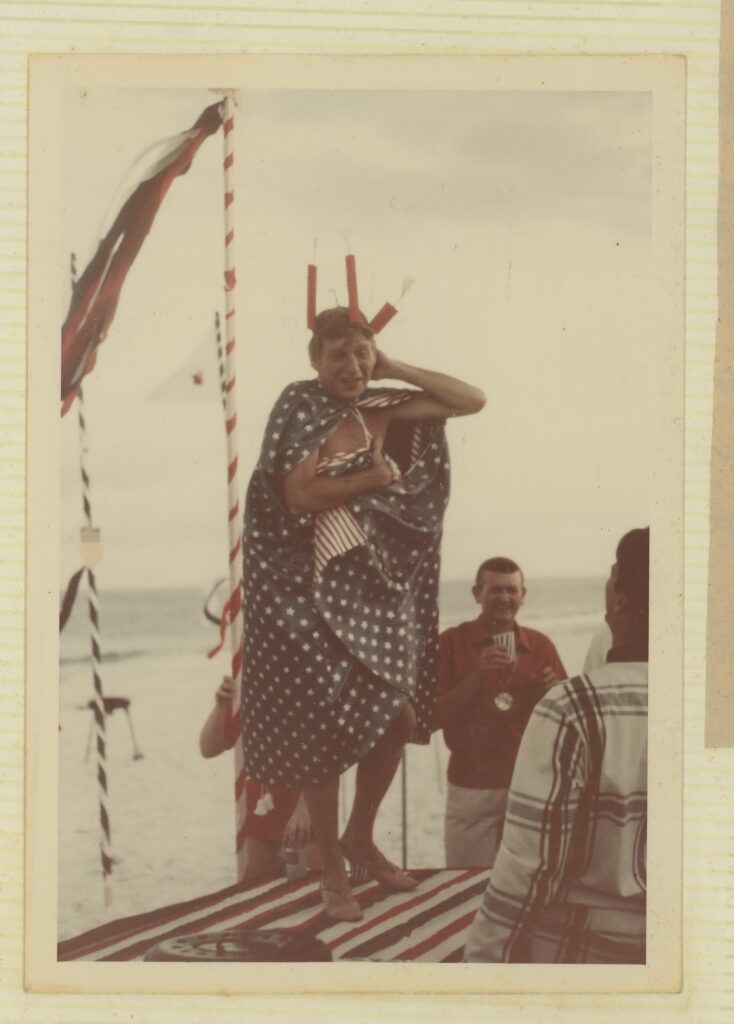
One indication of this history is that economics, rather than politics, made more of a difference to gay liberation in this region. Living in New York and steeped in its queer mythology, I was quite surprised to hear Watkins declare flatly, “It seemed like nobody here had heard of Stonewall until well into the 1980s. Stonewall made literally no difference on the Gulf Coast of Florida.” While protest marches, Pride events, and political organizations were very slow to take root in the region, LGBTQ communities made their mark economically. In the early 1990s, when another Christian Right–led backlash against gay and lesbian visibility erupted in Pensacola, the city pushed back—not because of the community’s activist prowess, but because of its economic muscle.
There are still many more stories to be told. Watkins acknowledges with frustration that “my book is very white and very male.” As a low-income graduate student, working full-time at Starbucks to maintain his urgently needed health insurance, he was limited to the archives he could easily access, which tended to marginalize the voices of lesbians and BIPOC queers. Since the book’s publication, he’s been slowly uncovering more stories that diversify the region’s queer history and is committed to continuing to amplify queer voices that have long languished in the shadows of the Sunshine State.
Beyond narrating its past, Watkins is actively engaged in the present and future of the queer South. He lives in Richmond, which he describes as “very hipster, very queer.” Williamsburg, where he teaches, is a smaller community with a more underground LGBTQ life. “There are a lot more queers here than are publicly out,” he observes. The town includes many older same-sex couples who moved to the region for their retirement years, forming quiet networks among themselves. The campus itself, however, is much more queer, he reports. The administration is mostly supportive—the dean of students is an out lesbian—and Watkins describes how joyous it is “to see students walking around holding hands, being openly queer in really interesting ways.”
As a teacher, Watkins is deeply committed to putting LGBTQ folks back into the story of America. He’s fortunate at William & Mary to have the latitude to teach a lot of fun courses. When he teaches regular US history surveys, he’s careful to incorporate LGBTQ people into all of the larger themes. After teaching courses on the modern South, “The Perverse South,” and “Monsters in America”—all about “the weird and wonderful things Americans have been scared of over the years”—he bit the bullet and proposed a class entirely on “The Queer South.” But even if the administration let him teach it, would students be interested?
He didn’t need to worry. The first year he offered the course, the 35 spaces were snapped up immediately, followed by a 65-person waitlist! To this day, it’s his favorite class to teach, and wildly popular among students of all genders and sexualities.
His teaching philosophy? “I’m committed to only having fun!” He remembers boring teachers from his own years in school and refuses to reproduce the same tired approaches. The flexibility he’s been offered at William & Mary enables him to experiment with creative topics and teaching methods, and it’s paid off. At a time when enrollment in history courses and undergraduate history majors are dropping nationally, in his department these numbers are growing, thanks to this tradition of innovative courses. And the enthusiasm of the students shows that there’s a growing interest in the past, present, and future of the queer South.
And what will he tackle next? There are two big projects on Watkins’ plate right now. The first explores the history of queer theater, broad but with a southern focus. Fascinated with the ways that LGBTQ creatives have used performance as a way of narrating our history, he’s excavating little-known stories of queer southerners on the stage, such as a North Carolina troupe called “Red Dyke Theater” from the 1970s. His students are helping to lead the charge, conducting oral history interviews with participants in queer theater projects in Richmond under his supervision.
The second is a biography of the renowned gay historian John Boswell, whose books on Christianity, homosexuality, and same-sex unions in medieval Europe broke new ground in the 1980s and 1990s before his tragic death from AIDS. The project came about through Watkins’ activism helping his university research the racist legacies of figures with campus buildings named after them. After his determined advocacy, with the support of the university’s president, there is now a Boswell Hall at William & Mary—so far as he knows, this is likely the first university building named after an openly gay person.
This is just one example of the impact Watkins is making through his scholarship and activism, queering the South region by region, class by class, building by building. And he’s not stopping any time soon.
He wants LGBTQ young folks growing up in the Panhandle or elsewhere in the South to know that “we’ve always been here.” For those like himself who’ve got the privilege to do so, he sees it as their duty to be out and visible. “I’ve got Silence = Death tattooed on my arm,” he declares—and no one is going to accuse Jay Watkins of being silent!
Of course, he recognizes that’s not possible for everyone. “If you need to be privately queer for a while until you can get to a place of safety,” he assures me, “that’s equally valid.”
He breaks out into a grin. “However you show up in life, the ancestors and the aunties are here for you!”
Thanks in part to Jay Watkins, we’ve got more stories to cherish from those ancestors and aunties than ever before—and the South is getting just a little bit queerer each day.
Want to read Queering the Redneck Riviera: Sexuality and the Rise of Florida Tourism? Purchase a copy through ShopQueer.co, and the author will receive double the income they usually would. Spectrum South also receives a 10% referral commission when our readers shop through this link. Queer readers support queer writers!


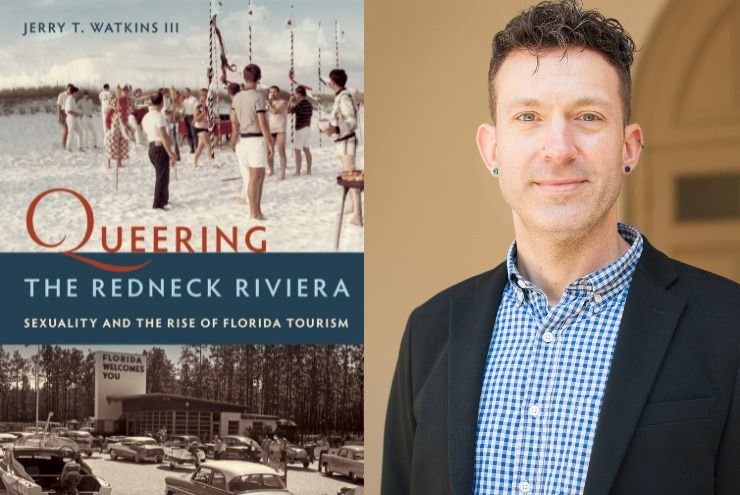
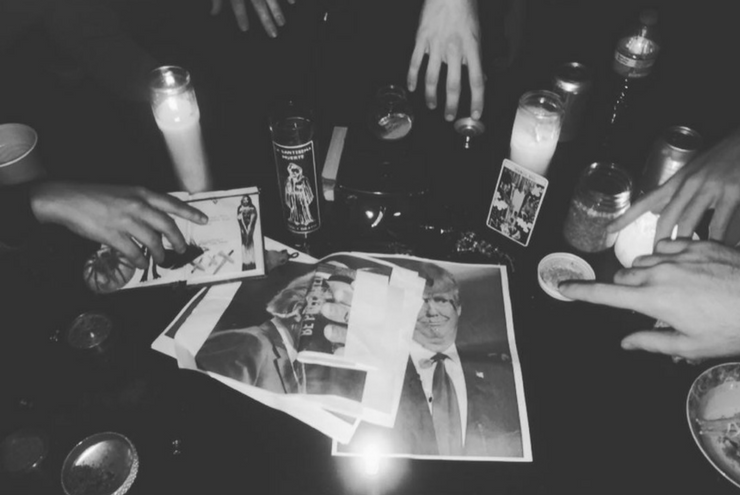
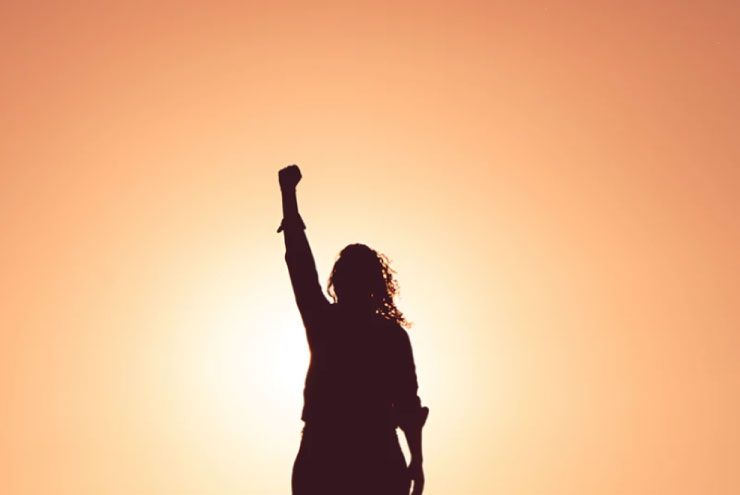



Historians of the Queer South: Announcing a New Spectrum South Series
July 14, 2023 at 8:25 PM[…] Jerry Watkins on Queering the Florida Panhandle (July 14, 2023) […]